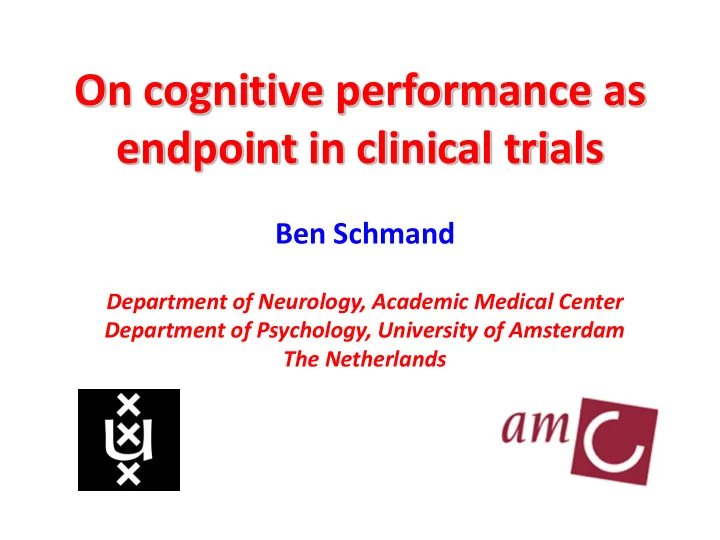

On cognitive performance as endpoint in clinical trials Ben Schmand Department of Neurology, Academic Medical Center Department of Psychology, University of Amsterdam The Netherlands
What are the best endpoints for clinical trials in MCI? • FDA wants cognitive and functional measures • ADAS-cog traditional cognitive measure • ADAS-cog not sensitive to change in MCI • Can neuroimaging provide better endpoints? • Or neuropsychological assessment?
Can neuroimaging provide better endpoints? Jack et al. Neurology 2003
Placebo controlled trial, 1 year duration, effect size = 50% reduction in rate of change, 90% power, p<.05 one-tailed ADAS-cog score: n=320 per arm Hippocampal atrophy: n=21 per arm
Required sample size in RCTs Is a function of – Size of effect one wants to detect Δ – Variance in untreated patients σ 2 – Level of statistical significance α – Statistical power of the study 1- β n / arm = 2 (z 1- α/2 + z 1- β ) 2 σ 2 / Δ 2
ADAS-cog is not very sensitive to change in AD, and even less in MCI
But what about a proper neuropsychological evaluation?
Improving the early Diagnosis of Alzheimer ’ s Disease and Other dementias (IDADO study) • Memory clinic patients • Inclusion criteria: – Possibly in early stage of dementia – Baseline and follow-up NP assessment + MRI scan • Exclusion criteria: – Dementia at baseline (clinical diagnosis) – Non-credible responding during NP assessment – Other brain disease that explains symptoms
IDADO study collaboration • • Anne Rienstra Jos de Jonghe • • Hyke Tamminga Medical Center Alkmaar • Edo Richard • Willem A. van Gool • • Gerard Walstra Ton d’Hondt • • Nikki Lammers GGZ Noord Holland • Ben Schmand • • Matthan Caan Bregje Appels • • Charles B. Majoie Jos van Campen • • Neurology & Radiology, Slotervaart Hospital Academic Medical Center Psychology department, University of Amsterdam
N=71 N=9 excluded Baseline non-credible SVT (n=5) diagnostic work-up, Gaucher ’ s, stroke, including NPA and MRI WM severely abnormal, Insufficient scan quality N=62 Follow-up after 2 yrs Clinical diagnosis Normal (CDR=0) Impaired (CDR>0) N=28 N=34 NPA and MRI
Patient characteristics at baseline and follow-up
Neuropsychological tests • Rey ’ s AVLT immediate recall • Rey ’ s AVLT delayed recall • Rivermead BMT prose immediate recall • Rivermead BMT prose delayed recall • Letter fluency (COWAT) • Stroop Color Word Test interference • Trail Making Test part B • T-scores are age, gender & education corrected Normally distributed in the general population T-scores: mean = 50, standard deviation = 10
FreeSurfer automatic partitioning and volumetry (3 Tesla MRI) MRI measures: hippocampal volume as percentage of intracranial volume and cortical thickness of entorhinal, middle temporal, and parahippocampal areas
Cognitive performance (L) and hippocampal volume (R) patients with normal cognition and declining patients Bars = standard error
N needed per arm n / arm = 2 (z 1- α/2 + z 1- β ) 2 σ 2 / Δ 2 Placebo controlled trial, effect size 50% reduction in rate of change, 80% power, p<.05 one-tailed Hippocampal atrophy: n=131 per arm Neuropsychological tests: n=62 per arm Note: Δ = 50% of (mean change impaired – mean change normal ) Thus delta is corrected for change in normal group 523 and 246 per arm for 25% reduction in rate of change
N needed per arm for various outcomes in a hypothetical RCT to detect 50% reduction in rate of change at 80% study power Schmand et al. JAD in press
Van Berckel et al. J Nucl Med 2013 MCI-patients (n=11) and controls (n=11) PiB PET scanning at baseline and after 2.5 years comparison of four analytic techniques
N needed per arm for various outcomes in a hypothetical RCT to detect 50% reduction in rate of change at 80% study power Van Berckel et al. Schmand et al. JAD in press J Nucl Med 2013
N needed per arm for various outcomes in a hypothetical RCT to detect 50% reduction in rate of change at 80% study power 300 Van Berckel et al. Schmand et al. JAD in press J Nucl Med 2013 250 200 150 100 50 0 cognitive ER cortical hippocampal PiB PET scan performance thickness volume (Logan DVR) corrected uncorrected for normal aging
What are the best endpoints for clinical trials in MCI? • FDA wants cognitive and functional measures • ADAS-cog traditional cognitive measure • ADAS-cog not sensitive to change in MCI • Can neuroimaging provide better endpoints? • Or neuropsychological assessment? • FDA prepared to consider NP assessment? (Draft Guidance for Industry, February 2013)
Bottom line & take home message • Track disease course or evaluate treatment? Then stick to the symptoms! (axiom) • Cognitive performance is most sensitive to change in MCI • Cognition should remain a primary endpoint provided it is measured in a sound way
b.schmand@amc.nl
Recommend
More recommend